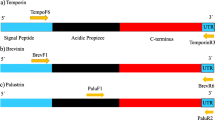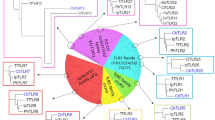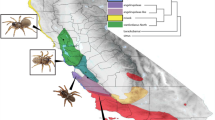Abstract
Ranatuerins are antimicrobial peptides of the innate immune system found in ranid frogs. We previously presented evidence that a positive selective sweep had fixed a single allele at the Ranatuerin2 locus in the northern leopard frog (Rana pipiens). In this paper, we further investigate the evolutionary history of ranatuerins as follows. First, we sequenced Ranatuerin2 in additional individuals of R. pipiens and related frog species and compared diversity and divergence at these sequences with that at four putatively neutrally evolving loci. Second, we asked whether the evolutionary patterns observed at Ranatuerin2 were typical for ranatuerin loci by sequencing our samples at a paralogous locus, Ranatuerin2b, and performing the same neutrality tests. Ranatuerin2b also showed strong and significant evidence of at least one selective sweep. Third, we used the neutral loci to independently resolve conflicting hypotheses about phylogenetic relationships among our study species. Both the neutral loci and the ranatuerin loci supported an older phylogeny inferred from allozyme data and strongly rejected a more recent phylogeny inferred from mitochondrial DNA. Finally, in order to test whether the sweep was driven by the evolution of substantially new peptide function, we used the phylogeny to reconstruct the hypothetical Ranatuerin2 peptide that existed before the sweep. We synthesized this peptide and tested its activity and that of the extant peptide against six bacterial pathogens of frogs. We observed antibacterial activity but found no significant functional differences between the two peptides.






Similar content being viewed by others
References
Ballard JW, Whitlock MC (2004) The incomplete natural history of mitochondria. Mol Ecol 13:729–744
Basir YJ, Knoop FC, Dulka J, Conlon JM (2000) Multiple antimicrobial peptides and peptides related to bradykinin and neuromedin N isolated from skin secretions of the pickerel frog, Rana palustris. Biochim Biophys Acta 1543:95–105
Bossuyt F, Brown RM, Hillis DM, Cannatella DC, Milinkovitch MC (2006) Phylogeny and biogeography of a cosmopolitan frog radiation: late cretaceous diversification resulted in continent-scale endemism in the family Ranidae. Syst Biol 55:579–594
Bradley GA, Rosen PC, Sredl M, Jones TR, Longcore JE (2007) Chytridiomycosis in native Arizona frogs. J Wildl Dis 38:206–212
Che J, Pang J, Zhao H, Wu G-F, Zhao E-M, Zhang Y-P (2007) Phylogeny of Raninae (Anura: Ranidae) inferred from mitochondrial and nuclear sequences. Mol Phylogenet Evol 43:1–13
Chinchar VG, Wang J, Murti G, Carey C, Rollins-Smith L (2001) Inactivation of frog virus 3 and channel catfish virus by esculentin-2P and ranatuerin-2P, two antimicrobial peptides isolated from frog skin. Virology 288:351–357
Conlon JM, Kolodziejek J, Nowotny N (2004) Antimicrobial peptides from ranid frogs: taxonomic and phylogenetic markers and a potential source of new therapeutic agents. Biochim Biophys Acta 1696:1–14
Conlon JM, Al-Ghafari N, Coquet L, Leprince J, Jouenne T, Vaudry H, Davidson C (2006) Evidence from peptidomic analysis of skin secretions that the red-legged frogs, Rana aurora draytonii and Rana aurora aurora, are distinct species. Peptides 27:1305–1312
Conlon JM, Al-Ghaferi N, Abraham B, Leprince J (2007a) Strategies for transformation of naturally-occurring amphibian antimicrobial peptides into therapeutically valuable anti-infective agents. Methods 42:349–357
Conlon JM, Coquet L, Leprince J, Jouenne T, Vaudry H, Kolodziejek J, Nowotny N, Bevier CR, Moler PE (2007b) Peptidomic analysis of skin secretions from Rana heckscheri and Rana okaloosae provides insight into phylogenetic relationships among frogs of the Aquarana species group. Regul Pept 138:87–93
Conlon JM, Ahmed E, Coquet L, Jouenne T, Leprince J, Vaudry H, King JD (2009) Peptides with potent cytolytic activity from the skin secretions of the North American leopard frogs, Lithobates blairi and Lithobates yavapaiensis. Toxicon 53:699–705
Culp CE, Falkinham JO III, Belden LK (2007) Identification of the natural bacterial microflora on the skin of eastern newts, bullfrog tadpoles, and redback salamanders. Herpetologica 63:66–71
Di Candia MR, Routman EJ (2007) Cytonuclear discordance across a leopard frog contact zone. Mol Phylogenet Evol 45:564–575
Drummond AJ, Rambaut A (2007) BEAST: Bayesian evolutionary analysis by sampling trees. BMC Evol Biol 7:214
Duda TF Jr, Vanhoye D, Nicolas P (2002) Roles of diversifying selection and coordinated evolution in the evolution of amphibian antimicrobial peptides. Mol Biol Evol 19:858–864
Felsenstein J (1989) PHYLIP, Phylogeny Inference Package (Version 32). Cladistics 5:164–166
Frost DR, Grant T, Faivovich J, Bain RH, Haas A, Haddad CFB, de Sá RO, Channing A, Wilkinson M, Donnellan SC, Raxworthy CJ, Campbell JA, Blottto BL, Moler P, Drewes RC, Nussbaum RA, Lynch JD, Green DM, Wheeler WC (2006) The amphibian tree of life. Bull Am Mus Nat Histol 297:1–370
Funk WC, Pearl CA, Draheim HM, Adams MJ, Mullins TD, Haig SM (2008) Range-wide phylogeographic analysis of the spotted frog complex (Rana luteiventris and Rana pretiosa) in northwestern North America. Mol Phylogenet Evol 49:198–210
Gibbs EL, Gibbs TJ, Van Dyck PC (1966) Rana pipiens: health and disease. Lab Anim Care 16:142–160
Goraya J, Wang Y, Li Z, O’Flaherty M, Knoop FC, Platz JE, Conlon JM (2000) Peptides with antimicrobial activity from four different families isolated from the skins of the North American frogs Rana luteiventris, Rana berlandieri and Rana pipiens. Eur J Biochem 267:894–900
Hillis DM (1988) Systematics of the Rana pipiens complex: puzzle and paradigm. Ann Rev Ecol Syst 19:39–63
Hillis DM (2007) Constraints in naming parts of the Tree of Life. Mol Phylogenet Evol 42:331–338
Hillis DM, Wilcox TP (2005) Phylogeny of the New World true frogs (Rana). Mol Phylogenet Evol 34:299–314
Hillis DM, Frost JS, Wright DA (1983) Phylogeny and biogeography of the Rana pipiens complex: a biochemical evaluation. Syst Zool 32:132–143
Hird DW, Diesch SL, McKinnell RG, Gorham E, Martin FB, Meadows CA, Gasiorowski M (1983) Enterobacteriaceae and Aeromonas hydrophila in Minnesota frogs and tadpoles (Rana pipiens). Appl Environ Microb 46:1423–1425
Hoffman EA, Blouin MS (2004) Evolutionary history of the northern leopard frog: reconstruction of phylogeny, phylogeography, and historical changes in population demography from mitochondrial DNA. Evolution 58:145–159
Hoffman EA, Schueler FW, Jones AG, Blouin MS (2006) An analysis of selection on a colour polymorphism in the northern leopard frog. Mol Ecol 15:2627–2641
Hudson RR, Kreitman M, Aguadé M (1987) A test of neutral molecular evolution based on nucleotide data. Genetics 116:153–159
Moore WS (1995) Inferring phylogenies from mtDNA variation: mitochondrial-gene trees versus nuclear gene-trees. Evolution 49:718–726
Peters JL, Zhuravlev Y, Fefelov I, Logie A, Omland KE (2007) Nuclear loci and coalescent methods support ancient hybridization as cause of mitochondrial paraphyly between gadwall and falcated duck (Anas spp). Evolution 61:1992–2006
Pfeiler E, Markow TA (2008) Phylogenetic relationships of leopard frogs (Rana pipiens complex) from an isolated coastal mountain range in southern Sonora, Mexico. Mol Phylogenet Evol 49:343–348
Posada D, Crandall KA (1998) Modeltest: testing the model of DNA substitution. Bioinformatics 14:817–818
Rohr JR, Schotthoefer AM, Raffel TR, Carrick HJ, Halstead N, Hoverman JT, Johnson CM, Johnson LB, Lieske C, Piwoni MD, Schoff PK, Beasley VR (2008) Agrochemicals increase trematode infections in a declining amphibian species. Nature 455:1235–1239
Rollins-Smith LA, Carey C, Longcore J, Doersam JK, Boutte A, Bruzgal JE, Conlon JM (2002) Activity of antimicrobial skin peptides from ranid frogs against Batrachochytrium dendrobatidis, the chytrid fungus associated with global amphibian declines. Dev Comp Immunol 26:471–479
Rozas J, Sánchez-DelBarrio JC, Messeguer X, Rozas R (2003) DnaSP, DNA polymorphism analyses by the coalescent and other methods. Bioinformatics 19:2496–2497
Shimodaira H, Hasegawa M (1999) Multiple comparisons of log-likelihoods with applications to phylogenetic inference. Mol Biol Evol 16:1114–1116
Tajima F (1989) Statistical method for testing the neutral mutation hypothesis by DNA polymorphism. Genetics 123:585–595
Taylor FR, Simmonds RC, Loeffler DG (1993) Isolation of Flavobacterium meningosepticum in a colony of leopard frogs (Rana pipiens). Lab Anim Sci 43:105
Tennessen JA, Blouin MS (2007) Selection for antimicrobial peptide diversity in frogs leads to gene duplication and low allelic variation. J Mol Evol 65:605–615
Tennessen JA, Blouin MS (2008) Balancing selection at a frog antimicrobial peptide locus: fluctuating immune effector alleles? Mol Biol Evol 25:2669–2680
Tennessen JA, Woodhams DC, Chaurand P, Reinert LK, Billheimer D, Shyr Y, Caprioli RM, Blouin MS, Rollins-Smith LA (2009) Variations in the expressed antimicrobial peptide repertoire of northern leopard frog (Rana pipiens) populations suggest intraspecies differences in resistance to pathogens. Dev Comp Immunol 33:1247–1257
Weins JJ, Sukumaran J, Pyron RA, Brown RM (2009) Evolutionary and biogeographic origins of high tropical diversity in Old World frogs (Ranidae). Evolution 63:1217–1231
Woodhams DC, Voyles J, Lips KR, Carey C, Rollins-Smith LA (2006) Predicted disease susceptibility in a Panamanian amphibian assemblage based on skin peptide defenses. J Wildl Dis 42:207–218
Zhou M, Wang L, Owens DE, Chen T, Walker B, Shaw C (2007) Rapid identification of precursor cDNAs encoding five structural classes of antimicrobial peptides from pickerel frog (Rana palustris) skin secretion by single step “shotgun” cloning. Peptides 28:1605–1610
Zhu S, Gao B (2009) A fossil antibacterial peptide gives clues to structural diversity of cathelicidin-derived host defense peptides. FASEB J 23:13–20
Acknowledgments
Samples were obtained with help from Eric Hoffman, Eric Tobin, Stephan Swanson, Kim Field, Ivan Phillipsen, and the Museum of Vertebrate Zoology. Becky Cooper, Vindhya Amarasinghe, and Dee Denver provided laboratory assistance. Jianzhi Zhang provided laboratory facilities and procedural guidance for the antibacterial assays. Joey Spatafora commented on an early version of the manuscript. This research was supported by an Environmental Protection Agency Science to Achieve Results fellowship to J.A.T. and an Idea Network of Biomedical Research Excellence grant (2 P20 RR016463) to the Nevada Genomics Center.
Author information
Authors and Affiliations
Corresponding author
Rights and permissions
About this article
Cite this article
Tennessen, J.A., Blouin, M.S. A revised leopard frog phylogeny allows a more detailed examination of adaptive evolution at ranatuerin-2 antimicrobial peptide loci. Immunogenetics 62, 333–343 (2010). https://doi.org/10.1007/s00251-010-0430-7
Received:
Accepted:
Published:
Issue Date:
DOI: https://doi.org/10.1007/s00251-010-0430-7




